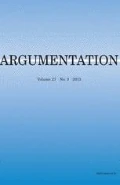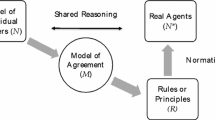Abstract
If arguments are to generate public knowledge, as in the sciences, then they must travel, finding acceptance across a range of local contexts. But not all good arguments travel, whereas some bad arguments do. Under what conditions may we regard the capacity of an argument to travel as a sign of its cogency or public merits? This question is especially interesting for a contextualist approach that wants to remain critically robust: if standards of cogency are bound to local contexts of evaluation, then how may arguments legitimately travel at all? The key to a contextualist conception of cogent travel, I argue, lies in the way local contexts are linked to broader contexts of evaluation by relations of relevance. The burden of the article is to elaborate the different forms these relations can take in the travel of scientific arguments.
Similar content being viewed by others
Notes
I thank Jean Goodwin for this observation.
For example, to assess the transactional merits of scientific discourse in a laboratory, one must understand both the goals and methods of the subdiscipline at issue (a public context) as well as the particular procedures employed by researchers at that laboratory for crafting their arguments; see Rehg (2009, chap. 7); for a case study see Staley (2004), Rehg (2009, chap. 6).
For a useful analysis of context, see Gilbert (2007): a context includes whatever factors in the environment affect how participants argue. Thus the context, in the broad sense, includes not only goals and shared background assumptions and field-specific rules and procedures, but also the relational history of the participants and ethos; for an early influential analysis of the rhetorical situation, see Bitzer (1968).
The construction process itself can take members outside their immediate laboratory context, as studies in the rhetoric of science have shown. Journal editors and referees are involved, and scientists typically test their arguments in discussion, conference talks, and the like. See Myers (1990) and Blakeslee (2001).
Here I draw on the usage of Walton (2004, pp. 11–15; 95–97), who distinguishes topical relevance, for which two subject matters must overlap, from material relevance, which concerns the question or stasis.
Taking truth about nature as a goal of inquiry is debatable, even within the natural sciences, but readers who prefer something like “empirically adequate claims about nature” can readily substitute it for “truth”; in broadening the community to that of inquiry in general, I aim to include interdisciplinary partnerships that reach beyond the science community, e.g., between scientists and philosophers of science.
References
Barbour, Ian G. 2000. When science meets religion. San Francisco: Harper.
Bitzer, Lloyd F. 1968. The rhetorical situation. Philosophy and Rhetoric 1: 1–14.
Blakeslee, Ann M. 2001. Interacting with audiences. Mahwah, NJ: Erlbaum.
Blaug, Ricardo. 1999. Democracy, real and ideal. Albany: SUNY Press.
Broad, William J. 2007. From a rapt audience, a call to cool the hype. New York Times March 13.
Cartwright, Nancy. 2006. Well-ordered science: Evidence for use. Philosophy of Science (PSA2004 Symposia Papers) 73: 981–990.
Fischer, Frank. 2000. Citizens, experts, and the environment. Durham: Duke University Press.
Garfinkel, Harold. 1967. Studies in ethnomethodology. Englewood Cliffs, NJ: Prentice-Hall.
Gilbert, Michael A. 2007. Natural normativity: Argumentation theory as engaged discipline. Informal Logic 27: 149–161.
Glen, William (ed.). 1994. The mass-extinction debates. Stanford: Stanford University Press.
Habermas, Jürgen. 1990. Moral consciousness and communicative action (trans: Lenhardt, C. and Nicholsen, S.W.). Cambridge, MA: MIT Press.
Habermas, Jürgen. 1996. Between facts and norms (trans: Rehg, W.). Cambridge, MA: MIT Press.
Haught, John F. 2000. God after Darwin. Boulder, CO: Westview.
Hilgartner, Stephen. 2000. Science on stage. Stanford: Stanford University Press.
Hitchcock, David. 1992. Relevance. Argumentation 6: 251–270.
Hull, David. 1988. Science as a process. Chicago: University of Chicago Press.
Jasanoff, Sheila. 1990. The fifth branch. Cambridge: Harvard University Press.
Johnson, Ralph H. 2000. Manifest rationality. Mahwah, NJ: Erlbaum.
Jordan, Kathleen, and Michael Lynch. 1992. The sociology of a genetic engineering technique: Ritual and rationality in the performance of the plasmid prep. In The right tools for the job, ed. A. Clarke and J. Fujimara, 77–114. Princeton: Princeton University Press.
Keller, Evelyn Fox. 1983. A feeling for the organism. New York: Freeman.
Kourany, Janet A. 2006. Getting philosophy of science socially connected. Philosophy of Science (PSA2004 Symposia Papers) 73: 991–1002.
Kusch, Martin. 2002. Knowledge by agreement. Oxford: Clarendon.
Lewandowski, Joseph. 2001. Interpreting culture. Lincoln: University of Nebraska Press.
Livingston, Eric. 1987. Making sense of ethnomethodology. New York: Routledge.
Lynch, Michael. 1993. Scientific practice and ordinary action. Cambridge: Cambridge University Press.
McPeck, John E. 1990. Teaching critical thinking. New York: Routledge.
Miller, Kenneth R. 1999. Finding Darwin’s God. New York: HarperCollins.
Myers, Greg. 1990. Writing biology. Madison: University of Wisconsin Press.
Rehg, William. 1997. Reason and rhetoric in Habermas’s theory of argumentation. In Rhetoric and Hermeneutics in our time, ed. W. Jost and M.J. Hyde, 358–377. New Haven: Yale University Press.
Rehg, William. 2005. Assessing the cogency of arguments: Three kinds of merits. Informal Logic 25: 95–115.
Rehg, William. 2009. Cogent science in context. Cambridge, MA: MIT Press.
Staley, Kent W. 2004. The evidence for the top quark. Cambridge: Cambridge University Press.
Tindale, Christopher W. 1999. Acts of arguing. Albany: SUNY Press.
Toulmin, Stephen E. 1958. The uses of argument. Cambridge: Cambridge University Press.
Turner, Stephen P. 2003. Liberal democracy 3.0. London: Sage.
van Eemeren, Frans H., and Rob Grootendorst. 2004. A systematic theory of argumentation. Cambridge: Cambridge University Press.
Walton, Douglas. 1996. A pragmatic theory of fallacy. Tuscaloosa: University of Alabama Press.
Walton, Douglas. 1998. The new dialectic. Toronto: University of Toronto Press.
Walton, Douglas. 2004. Relevance in argumentation. Mahwah, NJ: Erlbaum.
Ziman, John. 1968. Public knowledge. Cambridge: Cambridge University Press.
Acknowledgments
For feedback on earlier versions of this article, I thank Jean Goodwin, Ralph Johnson, and Christopher Tindale, the fellow co-members of a panel organized by Jean and chaired by Beth Innocenti Manolescu, on “Constructing Argument Space (II): Neighborhoods and Arguments in Motion,” National Communication Association, Chicago, November 15–17, 2007; I also thank audience members of that panel, and two anonymous referees for Argumentation.
Author information
Authors and Affiliations
Corresponding author
Rights and permissions
About this article
Cite this article
Rehg, W. Cogency in Motion: Critical Contextualism and Relevance. Argumentation 23, 39–59 (2009). https://doi.org/10.1007/s10503-008-9114-y
Received:
Accepted:
Published:
Issue Date:
DOI: https://doi.org/10.1007/s10503-008-9114-y




